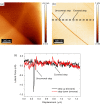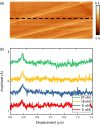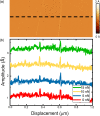Nanoscale spatial mapping of mechanical properties through dynamic atomic force microscopy
- PMID: 31355102
- PMCID: PMC6633814
- DOI: 10.3762/bjnano.10.132
Nanoscale spatial mapping of mechanical properties through dynamic atomic force microscopy
Abstract
Dynamic atomic force microscopy (AFM) was employed to spatially map the elastic modulus of highly oriented pyrolytic graphite (HOPG), specifically by using force modulation microscopy (FMM) and contact resonance (CR) AFM. In both of these techniques, a variation in the amplitude signal was observed when scanning over an uncovered step edge of HOPG. In comparison, no variation in the amplitude signal was observed when scanning over a covered step on the same surface. These observations qualitatively indicate that there is a variation in the elastic modulus over uncovered steps and no variation over covered ones. The quantitative results of the elastic modulus required the use of FMM, while the CR mode better highlighted areas of reduced elastic modulus (although it was difficult to convert the data into a quantifiable modulus). In the FMM measurements, single atomic steps of graphene with uncovered step edges showed a decrease in the elastic modulus of approximately 0.5%, which is compared with no change in the elastic modulus for covered steps. The analysis of the experimental data taken under varying normal loads and with several different tips showed that the elastic modulus determination was unaffected by these parameters.
Keywords: atomic force microscopy; contact resonance (CR) AFM; elastic modulus mapping; force modulation microscopy (FMM); highly oriented pyrolytic graphite (HOPG); mechanical properties; surface science; surface steps.
Figures












Similar articles
-
Mapping the elastic properties of granular Au films by contact resonance atomic force microscopy.Nanotechnology. 2008 Jun 11;19(23):235701. doi: 10.1088/0957-4484/19/23/235701. Epub 2008 May 7. Nanotechnology. 2008. PMID: 21825800
-
Linearizing the frequency-stiffness relation in contact resonance atomic force microscopy for facilitated mechanical characterization.Microsc Res Tech. 2022 Jun;85(6):2123-2130. doi: 10.1002/jemt.24070. Epub 2022 Feb 4. Microsc Res Tech. 2022. PMID: 35122360
-
Contact-resonance atomic force microscopy for nanoscale elastic property measurements: Spectroscopy and imaging.Ultramicroscopy. 2009 Jul;109(8):929-36. doi: 10.1016/j.ultramic.2009.03.025. Epub 2009 Mar 25. Ultramicroscopy. 2009. PMID: 19361926
-
Atomic Force Microscopy (AFM) on Biopolymers and Hydrogels for Biotechnological Applications-Possibilities and Limits.Polymers (Basel). 2022 Mar 21;14(6):1267. doi: 10.3390/polym14061267. Polymers (Basel). 2022. PMID: 35335597 Free PMC article. Review.
-
Nanomechanical mapping of soft materials with the atomic force microscope: methods, theory and applications.Chem Soc Rev. 2020 Jul 14. doi: 10.1039/d0cs00318b. Online ahead of print. Chem Soc Rev. 2020. PMID: 32662499 Review.
Cited by
-
Torsional and lateral eigenmode oscillations for atomic resolution imaging of HOPG in air under ambient conditions.Sci Rep. 2022 May 28;12(1):8981. doi: 10.1038/s41598-022-13065-9. Sci Rep. 2022. PMID: 35643777 Free PMC article.
-
Electro-Mechanical Properties of Metallized Sodium Alginate Foils at the Limit of the Electrical Conduction.ACS Omega. 2025 Jul 18;10(29):32326-32338. doi: 10.1021/acsomega.5c04447. eCollection 2025 Jul 29. ACS Omega. 2025. PMID: 40757360 Free PMC article.
References
LinkOut - more resources
Full Text Sources
Miscellaneous
